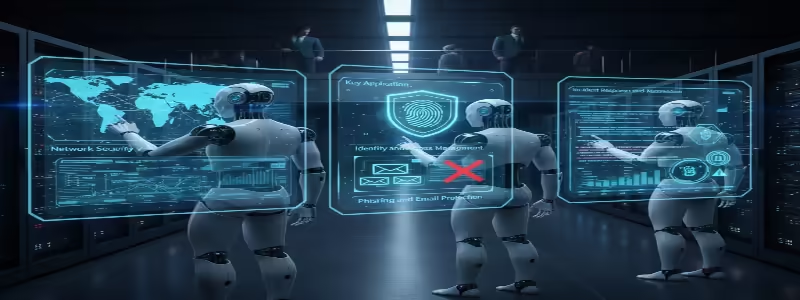AI in Cyber Defense: What Machine Learning Can Do To Prevent An Attack
The rapid interconnection of the world has been one of the main reasons for cyber emergence of brand-new kinds of cyber threats. In addition to phishing, ransomware, and state-sponsored cyberattacks, organizations are still battling a digital war every day to safeguard their data and systems.
In fact, security measures such as firewalls and antivirus software, which were once considered powerful, are now downgraded to almost negligible security in the present era. These can only detect already known threats but are almost powerless against new, intelligent attacks that change and adapt instantly.
That point is exactly where the AI in the role of cybersecurity becomes very essential. Today, Artificial Intelligence and machine learning systems are used to foresee, detect, and even stop cyberattacks at the very source. AI tools in cyber defense, through processing a huge amount of data and finding abnormal behaviour patterns, are radically changing the way organizations are securing themselves in the digital age.
The Rise of AI in Cybersecurity

The global cybersecurity terrain has shifted remarkably in the last ten years. The proliferation of cloud computing, the Internet of Things (IoT) devices, and remote work has led to an exponential increase in the number of attack points. No human analyst working alone would be capable of monitoring every event or identifying every anomaly as they occur, in real time.
Such an increase in complexity has made the use of AI in cybersecurity a necessity and the latter being a domain where the use of algorithms, automation, and predictive analytics has resulted in the detection and the response to the cyber threats being done at least as fast and more effectively as before, if not faster.
AI systems do not solely depend on the use of predefined rules or the signatures of the known malware; rather, they learn from data. As a result, they are capable of finding new patterns, discovering zero-day threats (newly found weaknesses), and even proposing automatic actions.
Basically, AI is not just a tool to prevent cybercrime; however, it is designed to learn from it too.
How AI and Machine Learning Work in Cyber Defense

Before we discuss the real-world applications, we need to understand the basics of AI and machine learning security systems.
- Data Collection and Training
AI models require very large datasets for training. In cybersecurity, the necessary data can be extracted from network logs, email, user activity, and the records of attacks. The system defines the standard or "normal" behavior based on this data. - Pattern Recognition
Post the training phase, AI algorithms do not cease to explore the data for familiar patterns. For one, a user logging in from an unusual location or downloading an extremely large number of files could prompt AI to flag the activity as suspicious. - Anomaly Detection
Machine learning-based security not only enables the detection of anomalies but also the identification of anomalies in normal patterns. Thus, it can uncover the threats that bug traditional security systems, such as a gradually silent data exfiltration or an insider threat, for example, a difficult-to-trace infected system. - Automated Response
The AI cyber-attack defense tools stage the most advanced could, without any human help, directly perform some operations such as the isolation of a compromised system, the blocking of a suspicious IP address, or the sending of alerts to administrators before the threat gets to them.
In short, AI-driven systems are just like smart digital guardians who never rest and keep upgrading their skills.
Why Traditional Security Measures Aren’t Enough
For quite a long time, companies have been relying on traditional signature-based anti-virus detection systems which are able only to identify the known patterns of malware, or on firewalls which simply reject that kind of traffic which has been previously set. Though these methods are still of great importance, they have a significant limitation - they can only recognize what they already know.
Hackers these days are using very complicated techniques such as polymorphic malware that keeps continuously changing its code and so no one can detect it. In addition, they use social engineering that makes security systems even less effective because the criminals are using the human factor to their advantage.
Old systems merely react to a security breach. But the use of AI in cybersecurity is more advanced and therefore, a proactive system. It predicts and prevents hijacking before they happen.
Key Applications of AI in Cyber Defense

- Threat Detection and Prediction
AI is really good at finding activities that are not usual. Security systems that are powered by machine learning can dive through extensive datasets of network traffic, user behavior, and system logs to find slight indications of technological threats.For instance, if it is noticed that an employee’s account is accessing sensitive files that it has never accessed before and at strange times, AI can notify the administrators right away.
Even more, predictive models can anticipate possible weak spots in security and give a hand to the security team in fixing them before the hackers take advantage of them.
- Phishing and Email Protection
The method of attack known as phishing is still among the most frequently used. Email filters that are supported by AI are capable of recognizing the suspicious words, links, and behavior of the sender so that malicious emails may be automatically stopped without any intervention from humans. In contrast to the usual spam filters, these systems learn with every new attack, becoming increasingly intelligent as time passes. - Malware Detection
AI-powered cybersecurity tools of today are beyond Antivirus that rely fundamentally on signatures. They in a live environment watch over files in the real-time manner. If a file behaves suspiciously, such as trying to change the system files or encrypt the data without authorization, then the AI can immediately intervene.The process of behavior analysis is what makes AI very potent against the likes of ransomware and zero-day malware.
- Network Security and Intrusion Detection
AI is always one step ahead and keeps tabs on network activities to spot the odd ones out. It can uncover communication patterns between devices, detect access attempts of an unauthorized nature, and point out breaches of data that could be going on before they have the chances of growing. - Identity and Access Management
By the use of AI, firms are capable of setting up adaptive authentication which means that the system changes security needs depending on the level of risk. For example, a login from a familiar device might just require a password but a login from a new place might activate multi-factor authentication. - Incident Response and Automation
When the cyber incident happens, every second counts. AI in cybersecurity is very instrumental in automating initial response activities like isolating infected devices, blocking access from certain IP addresses, or gathering the necessary evidence for the case, thus it is a tool that saves analysts a lot of time which they can use to focus on other complex parts of the decision-making process.
Popular AI Cyber Defense Tools
It has been set by several top AI-driven security tools that they have broken the industry standards in the last couple of years:
- Darktrace: It relies heavily on unsupervised machine learning that allows it to detect and react to cyber threats instantly. Being the “immune system” of the network, it is praised for its method of understanding the normal operation of the network.
- CrowdStrike Falcon: It is an AI-based tool that is capable of the detection of malware along with other suspicious activities over endpoints.
- Cylance: An AI antivirus tool, driven by the first, to use AI-powered predictive algorithms to prevent infections before the execution of the malicious code.
- IBM QRadar Advisor with Watson: Security IBM Watson AI is integrated to help the system comprehend security incidents and automate reactions.
- Microsoft Defender 365: Machine learning security methods are implemented to find progressively difficult threats in the case of emails, endpoints, and cloud systems.
The Benefits of Using AI in Cyber Defense
- Speed and Efficiency: AI is capable of going through data and finding irregularities in a matter of seconds - the very same task that it would take human analysts a couple of hours or days. This reaction in haste is essential in the role of stopping data breaches.
- Handling Large-Scale Data: Most networks these days generate huge amounts of security logs. The machine learning-based security systems can get through this data without difficulty, thus leaving no security threat undetected.
- Improved Accuracy: Where AI systems take advantage of training sets is in their learning from the practice of security breaches. As a result, they improve the detection algorithms that give fewer false positives gradually.
- Predictive Power: The most valued feature of AI in cybersecurity is that it is preventive. Rather than being a reactionary force, it is an anticipatory one. Predictive analytics are capable of discovering the weak points and providing organizations with the chance to fix the vulnerabilities before hackers take advantage of them.
- 24/7 Protection: Artificial-Intelligence (AI)-powered security systems differ significantly from human security analysts as they do not get tired. In a sense, they are always on the job and deliver uninterrupted, real-time supervision for every hour of the day and every day of the week, which implies that the highest standard of security is always guaranteed.
Challenges and Limitations of AI Cyber Defense
- Data Quality and Bias: An AI system will be as powerful as the dataset that it uses for its learning. If the data is incomplete or biased, it can result in the wrong identification of the threats or even failure to detect the intrusions.
- Cost and Complexity: AI-powered cybersecurity tool installation can be a hefty sum and can also be a complicated process from the technical side. It can be quite challenging for small businesses both in terms of the infrastructure and the availability of the experts.
- Adversarial Attacks: Hackers are now focusing on the AI systems themselves with the help of the "adversarial attacks" method. In this modus operands, they tamper with data inputs to fool AI algorithms, making them misclassify the threats.
- Lack of Human Oversight: One of the main purposes for which Artificial Intelligence should be used is to help, rather than substitute, the work of human analysts. In cases where a malfunction in AI is taking place, without the supervision of humans, the AI can misjudge a complex situation and cause the escalation of a crisis.
The Role of Human Expertise in an AI-Driven Security World
Even though AI handles detection and response automatically, the role of human intelligence cannot be overlooked. Analysts in the field of cybersecurity offer the necessary context, decide, and think creatively all which AI is not capable of.
A strong cyber security plan combines the use of AI-powered cyber tools with the skill of the human workforce. People are involved in the process of training the AI, understanding the outcomes, and making the right moral choices when the fraction of automation is insufficient.
The collaboration keeps companies from being victims of hackers, as they still have the power to make decisions.
The Future of Machine Learning Security

As the security of machine learning evolves, the future of cyber defense is on its way to a stage where it will be completely predictive and adaptive. Some of the trends that are bringing that future are as follows:
Self-Healing Networks:
Systems that can uncover, separate, and fix all the weak spots without any human intervention need.
Behavioral Biometrics:
AI that gets the identity of the user from the way he types, moves the mouse, or touches the device, thus making the authentication more robust.
AI Collaboration:
The union of numerous AI tools that share the same intel about possible threats in real time.
Quantum-Resistant AI Models:
New AI systems that will be around to protect against hacking which is caused by quantum computing are being created as a result of quantum computing innovations.
Not just fast responses but intelligent predictions and prevention of the cybersecurity threats will be the factors that will determine cybersecurity in the future.
Conclusion

On the one hand, AI is one of the biggest threats in cyberspace causing ever more complex and unpredictable attacks. On the other hand, AI in security stands for a technological leap from reactive defense to proactive protection.
Moreover, with tools like AI cyber defense and machine learning based security systems, the organizations can spot the irregularities, foresee breaches, and even facilitate the responses thus, they can stop the attackers right in their tracks, long before they get to the point of attack.
Nevertheless, the most powerful strategy is still a combination of human skill and AI. The better this teamwork gets, the more the future of cyber defense will look like being smarter, quicker, and safer by far.
When we live in a world where data is the new money, AI is the safest place that keeps it secure.